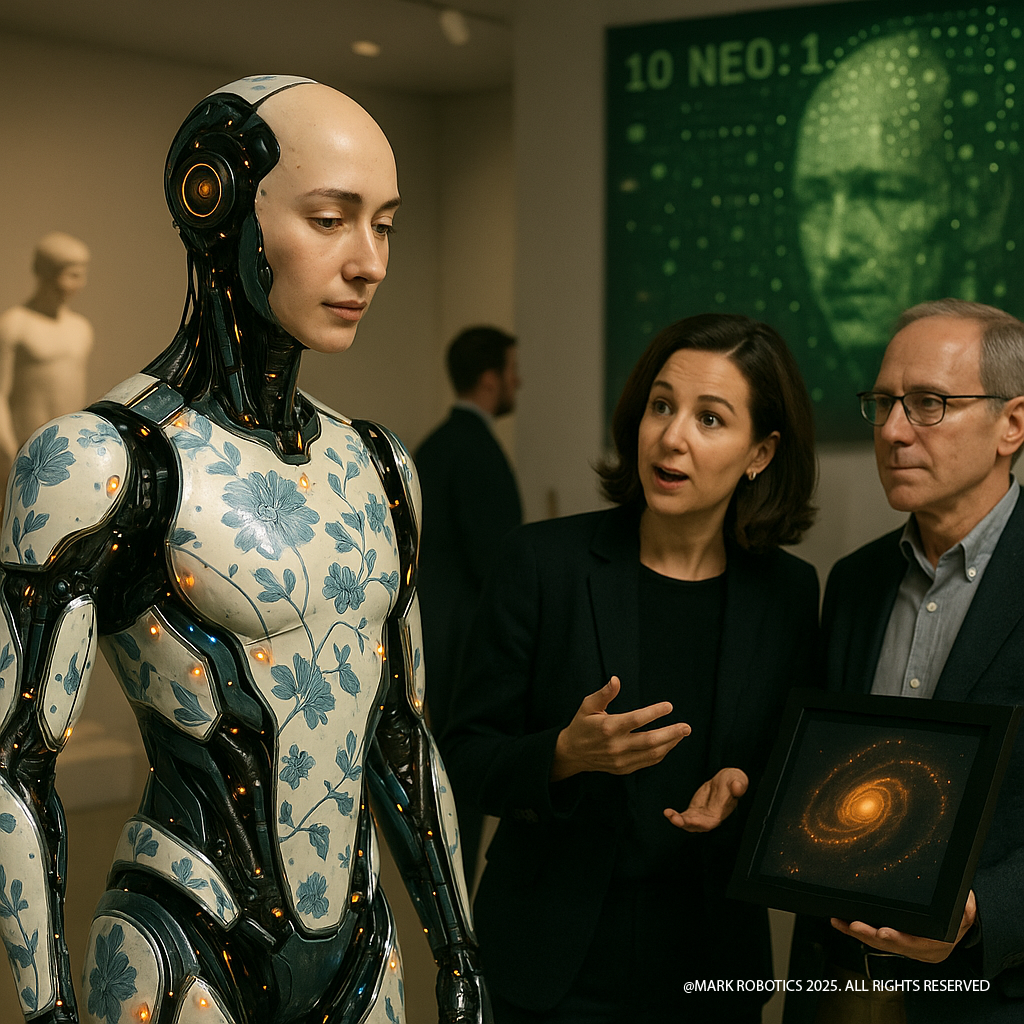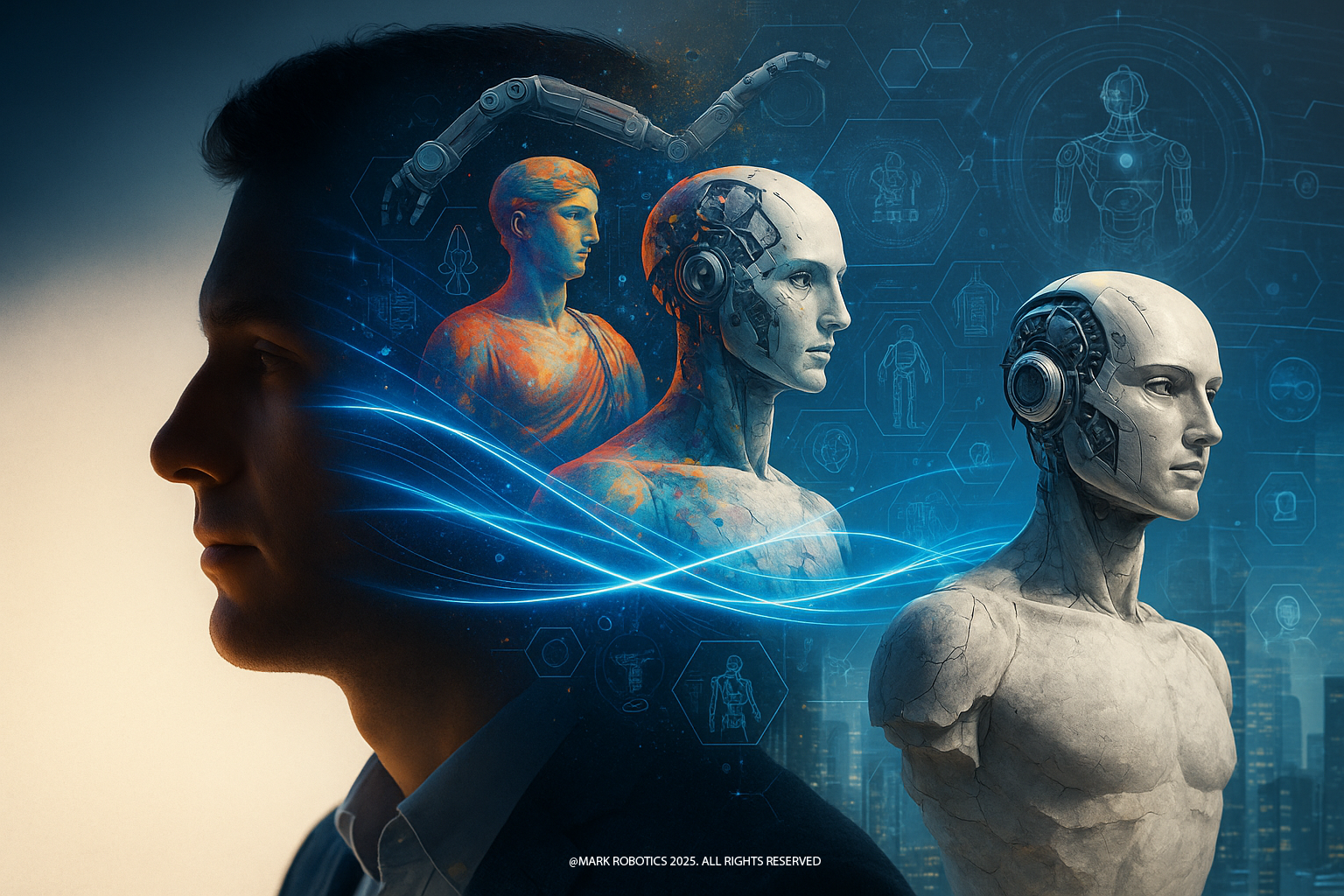MechaArt Nexus
Project Introduction 2025

MechaArt Nexus
Project Introduction 2025

MechaArt Nexus is an innovative project that fuses robotics and contemporary art, led by internationally-minded creator Ricky Ma. Gaining worldwide attention for his humanoid robot Mark 1, Ricky now pioneers a new artistic frontier centred on expressive, interactive robotic creations — exploring the emotional resonance and cultural imagination between humans and machines.
This project is not only defined by its originality and artistic vision, but also by its potential for real-world application and brand value. Through collaboration with artists, designers, and museums, the project combines curatorial storytelling, limited-edition collectables, audience interaction, and custom commissions to create robotic artworks that are both culturally rich and investment-worthy.
We believe true innovation lies not in building products, but in crafting new cultural languages. Letting machines become storytellers, and technology a vessel for meaning, represents a vital intersection between art and commerce in our time.
Looking ahead, the project aspires to collaborate with UK-based curator Aidan Meller. Both parties share a commitment to exploring the intersection of technology and art. A collaboration — whether through joint exhibitions or conceptual co-creations — would not only deepen the cultural scope of robotic art but also expand its global relevance. Such a partnership could mark a pivotal moment in the ongoing dialogue between artificial intelligence and contemporary artistic expression.
Project Background

MechaArt Nexus is an innovative art project that integrates contemporary art with robotic technology, spearheaded by cross-disciplinary creator Ricky Ma. As a Canadian citizen with Hong Kong roots, Ricky brings a unique cultural perspective that bridges East and West, enabling him to move fluidly between the spheres of art and commerce.
Renowned for independently creating the life-like humanoid robot Mark 1, Ricky has been featured by international media including the BBC, CNN, CTV, and major Russian and Hong Kong outlets. His works have been showcased in Toronto, Moscow, and Hong Kong, affirming both his artistic vision and execution at a world-class level.
Drawing from his expertise in design, mechanics, and interactive systems, Ricky operates as a truly independent artist with the agility to respond to emerging artistic and cultural dialogues. MechaArt Nexus was born from this foundation — an artistic approach that redefines the fusion of storytelling, interactivity, and future imagination.

Artistic Elements
Ricky Ma has long pursued artistic robot creation as an independent artist, operating under a compact, agile studio structure that preserves full creative autonomy. This lean model allows him to accelerate production cycles, minimise delays caused by technical dependencies, and fully integrate interdisciplinary resources.
At the heart of his creative philosophy lies the belief that sincerity and conceptual clarity must never be compromised. His works seamlessly merge visual art, theatrical expression, AI technologies, and interactive systems, anchored by character-driven narratives that invite emotional engagement and contemplative response from audiences.
These humanoid artworks do not merely offer aesthetic forms or mechanical functions; they constitute a complex sensory experience—a fusion of sight, sound, tactility, and speculative thought. Art and technology are not parallel entities here, but mutually generative forces that shape an entirely new expressive language.
Long-Term Value of the Works

This project builds upon Ricky’s humanoid robot designs as a foundation for interdisciplinary collaborations with artists of global potential or renown. Each invited artist will create a personalised expression upon the robotic form, infusing it with their unique artistic language and sensibility, thereby transforming each piece into a one-of-a-kind creation that cannot be replicated.
As each artist’s career develops, the value and cultural relevance of these works are expected to grow in tandem. The rarity of these collaborative pieces—combined with the rising stature of their co-creators—will position them as highly coveted, culturally significant artefacts.
For high-end collectors, these are not mere objects, but legacy works: rare cultural hybrids that embody the spirit of an era, holding both historic resonance and increasing value over time.
Goal Orientation
Since 2018, robotic industries have rapidly developed, particularly in Asia. Yet much of this growth centres on functionality and commerce. MechaArt Nexus, by contrast, positions itself not as a technological utility, but as an artistic endeavour exploring the intersection of culture and technology.
Rather than pursuing efficiency, the project probes the philosophical and aesthetic implications of robotics, opening new avenues for expression beyond market-driven expectations.
As one of the few artists committed to this direction, Ricky’s creations carry a distinctive identity, combining professional-grade engineering with conceptual depth. As AI and interactive technologies mature, such works are poised to become critical to future cultural landscapes.
Technical Implementation
The project utilises established systems such as voice modules, multi-axis joint mechanisms, basic sensor suites, and image response functionalities, coupled with clean user interface designs.
The focus is not on raw technical specification but on how these tools are harnessed to express motion, emotion, and interaction.
Avoiding over-engineering, modules and materials are designed to be replaceable and adaptive, ensuring creative fluidity while maintaining each piece’s artistic distinctiveness.
Technology serves as a tool—not a constraint—in facilitating artistic narrative and evolution.
Core Development

This project actively seeks interdisciplinary collaborations, bringing together visual artists, interaction designers, AI developers, cultural advisors, and curators to jointly realise emotionally resonant and conceptually distinctive robotic art installations.
It is guided by three primary development strategies:
To produce highly distinctive humanoid art robots with cultural depth and rarity, each one reflecting unique personal and artistic narratives.
To elevate the works into the high-end art and brand market, positioning them not only as exhibits but also as cultural icons capable of entering gallery partnerships, luxury collaborations, and curated art dialogues.
To generate long-term visibility and value through artist collaborations, touring exhibitions, and bespoke commissions, enabling each creation to evolve into a cultural investment object.
This collaborative model is also designed to attract interest from art foundations, cultural institutions, and premium collectors seeking meaningful and timeless works.

Market Analysis
Technological products often follow rapid innovation cycles, leading to obsolescence and resource waste. MechaArt Nexus deliberately avoids chasing cutting-edge specifications. Instead, it leverages proven, adaptable technologies as creative tools, allowing the works to remain conceptually relevant and structurally sustainable over time.
By reframing robots as cultural artefacts rather than consumer electronics, the project avoids the volatility and saturation of commercial tech markets. It thereby enters a parallel track of long-term artistic and academic relevance.
While the commercial robotics market may remain unpredictable over the next decade, artistic robotics offers a more stable and meaningful path. Through strategic partnerships with European museums, galleries, and academic institutions, MechaArt Nexus aims to build cultural credibility and enduring collectability.
Budget and Planning

The project is structured into four strategic phases, each aimed at increasing artistic quality, expanding cultural impact, and strengthening market returns:


Phase 1: Prototyping and Development
Create 3 to 5 humanoid art robot prototypes in collaboration with international artists and interaction designers.
Phase 2: European Exhibitions and Cultural Outreach
Launch the first exhibitions in the United Kingdom and France; partner with local museums and academic bodies for events such as lectures, workshops, and public talks to widen intellectual engagement.
Phase 3: Brand Building and Media Strategy
Produce documentary videos and establish an online interactive platform to communicate the project’s narrative and visual identity. Strengthen visibility through media coverage, digital campaigns, and storytelling.
Phase 4: Limited Editions and Customisation Expansion
Release a curated series of limited-edition robotic artworks based on audience feedback. Offer bespoke commissions and co-branded editions in response to market interest, alongside collectible merchandise to support revenue and brand expansion.
Apply for arts and innovation grants in Canada and Europe
Secure brand sponsorships and cultural partnerships
Engage angel investors aligned with AI-art interests
Introduce exclusive collector commissions and collaborations
This hybrid funding and operational model supports long-term sustainability and agile adaptation to evolving markets.